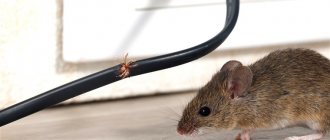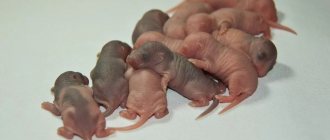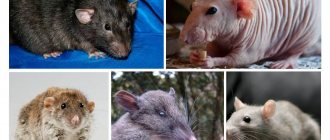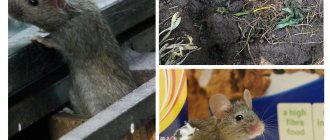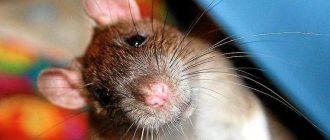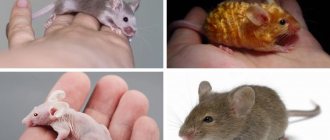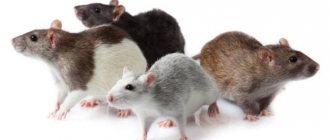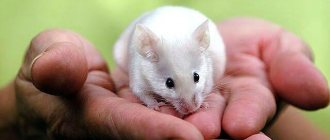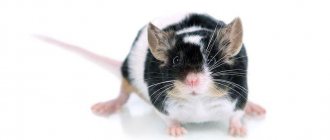Mice and rats belong to the group of cosmopolitan species, which implies a wide distribution area of these mammals, which live in all corners of the planet, with the exception of mountainous areas and zones of the Far North.
Both of these species are characterized as synanthropic, that is, even wild members of the family live near human habitation, which facilitates access to food sources. Most people believe that the only difference between rats and mice is the difference in size. This is true, rats are large, but there are other differences that are worth considering in detail.
Differences in appearance
Due to the external similarity, not every person can recognize the differences between a mouse and a rat. Both rodents have gray fur and a long tail. But there are also many differences in their appearance.
Dimensions
Size is the main difference by which these rodents can be distinguished. The average body length of a baby rat is 7–10 cm, the same as an adult mouse. And rats grow up to 25 cm.
The weight of rodents also differs significantly. Rats are larger and therefore heavier than mice. An adult weighs on average 220–250 g. Moreover, males are much larger than females. Their weight with proper nutrition can reach 450 g. An adult mouse weighs only 45–85 g.
Important! In rare cases, rats can grow to gigantic sizes. In nature, there were individuals whose weight exceeded 1 kg. The length of such a rodent can reach 40–50 cm.
Head and ears
Mice differ from rats in the shape of their heads. In rats, the muzzle is strongly extended forward. And in mice it is slightly shorter and has a triangular shape. Rats have much smaller eyes.
Outwardly, they resemble black beads. Mice have large and mobile eyes. Rodents also rotate their heads differently. To do this, rats need to move their torso, and mice can twirl it without the participation of the body.
Mouse
Rats and mice differ from each other in the shape of their ears. In large rodents they are small, triangular and covered with sparse villi. In some subspecies their ends are blunted.
A mouse differs from a rat in having larger, movable ears that it can move. Rats can't do that. Mice have round ears and no hair on them.
Paws and tail
Due to their size, rats move primarily in horizontal places. To find food and escape from predators, they need to run fast and jump high. Therefore, their paws are powerful and muscular, and between the toes there are rough outgrowths of skin visible - these are rudimentary membranes.
Due to their light weight, mice can easily climb vertical surfaces. They are helped in this by small and flexible paws with tenacious claws.
Mouse
Rats have a short tail. It is thick and bristly, there is no hair on it. Its size is approximately half the length of the individual’s body. Mice have a thin tail. Its length is at least ¾ of the body size.
Rat
Wool
Rats have dark gray, dirty-colored fur. The hairs are thick and coarse, and the skin underneath is easily visible.
Important! Decorative individuals have softer wool. Its color depends on the species. Pet stores sell white, red, gray and black rodents. There are also individuals with a hood of a different color.
Decorative rats
The fur of mice is softer and silkier. These rodents have a smoky, grayish color. The hairs grow denser, so the skin is not visible through them.
Mice
What do the tracks look like?
What do rodent tracks look like?
The imprint of a rat's front paws on wet ground or snow is approximately 1.5 x 2 cm in size. You can see traces of 4 toes, which are widely spaced. The hind legs are larger (up to 4 cm), however, during movement, a small imprint remains - 2x2 cm, i.e. the mark is only partially visible. If the animal moves slowly, a thin chain of prints will remain on the surface. During the jump, the rat leaves rare traces - at a distance of up to 1.5 m.
The paw prints of mice during a jump are characterized by a smaller step (up to 30 cm). The tracks form a kind of trapezoid: when moving, the mouse places its hind legs wider, pushing off with its front, closely spaced legs. As a result, the tracks of the hind paws remain in front, and the tracks of the front paws remain behind. In addition, a thin line is visible behind - from the tail.
Intelligence difference
If we compare the intelligence of two types of rodents, then mice are much inferior to rats, which are more intelligent. Scientists equate their intelligence to that of cats and even dogs. These are careful animals.
They assess the area they intend to settle in, study it for potential dangers, and leave if they see a serious threat. Other amenities are also important to them: they know how to assess the temperature of the room and the quality of food. If the food seems dangerous to them, they will not take risks.
Rat
Mice are not capable of such actions. They assess the territory worse and easily eat poison. Small rodents are more likely to become victims of predators because they leave behind many traces and cannot identify potential danger.
The difference in intelligence is also noticeable in the fact that mice gather in packs less often, they do not have a clear hierarchy and defined roles. Rats always live together. Each individual in the pack has its own responsibilities. For example, before settling into a new territory, a small group of rodents must explore it. If she seems safe to them, then the rest of the pack will follow.
Rats
Important! Rats are very aggressive. They often attack mice and kill their relatives if they feel threatened by them. Sometimes they attack weakened individuals if the flock lacks food.
Rats easily recognize danger and try in every possible way to avoid it. When they see a predator, they run away to a previously found shelter. Mice act chaotically, rushing around in circles, so they get caught more often.
Animal behavior
If you fail to catch a rodent, you should pay attention to the traces it leaves. The paw prints left by rats are quite clear and sparse, since they move in hops. As for the tracks left by mice, they are more frequent. A careful inspection of the lower part of the walls will help you identify the uninvited guest. When rats move, they press against the surface, leaving abrasions. Mice are more careful in this regard, so there are no characteristic marks left behind. Pasyuk is a rather aggressive creature that can attack a person if it feels that his life is in danger, which cannot be said about the practically harmless mouse, which often runs away at the sight of a person.
The house mouse is one of the most common species of mammals, whose life is closely related to humans.
Intelligence difference
In terms of mental development, a rat is significantly superior to a mouse. Some people even compare large rodents to dogs and cats. They are more careful and discerning. When choosing a new place to settle, Pasyuks first explore the territory to make sure it is safe. Because of this quality, it is quite difficult to get rid of rats using various poisons. Due to the ability of a large rodent to regulate its population, as soon as the rat population decreases, the number of litters increases.
Mice and rats (video)
Food preferences
You can also determine the type of pest by assessing the property. Unlike mice, which like to spoil soft objects (paper, cellophane, polystyrene foam, leather, as well as seeds, flour and cereals), rats, which are not particularly picky eaters, prefer hard surfaces. They eat both meat and plant foods, so they can cause damage to absolutely any food found in the house. Pasyuki are mainly found in places with household and food waste.
Differences in nutrition
Both species are omnivores, but rats and mice can be distinguished by their feeding habits. Both of them are predators. They can attack other animals and insects and eat their meat.
Rats are more aggressive. Wild individuals hunt more often and mainly in packs. But they can attack alone. Small and weakened animals, including mice, often become victims of rats. When there is a shortage of food, rodents also attack each other. More often than mice, they feed on human household waste, so entire flocks often live in landfills.
Rats
Mice eat meat less often. These rodents prefer plant foods. They regularly replenish their supplies with leftover vegetables, seeds, and cereals. But this does not mean that mice will refuse meat. They will eat it with pleasure, but they will not hunt for it.
Mouse
What do rats and mice have in common?
These mammals belong to the order of rodents of the mouse family. There are other common features. Because of them, these two species are often confused.
Mice and rats: general features of life
Both of them belong to cosmopolitan species. That is, these rodents inhabit all corners of the Earth except Antarctica and the Far North, and they are not found high in the mountains.
These rodents are considered synanthropic, that is, associated with humans. Wild subspecies live in human homes, utility rooms or those intended for keeping pets. Although in warm regions they can live far from human habitation.
Rodents are animals with a nocturnal and twilight lifestyle. They are most active at sunset. However, when kept in captivity, animals adapt to the rhythm of life of the owner, get used to staying awake in the light and reducing activity during human rest.
These types of rodents are very active. They climb, run, jump and swim beautifully. Possessing high plasticity of the body, the animals can “leak” into very small crevices.
In nature, mice prefer to live in colonies in which they maintain a hierarchy. Adult males can start fights among themselves. In families, aggression sometimes spreads to older offspring, which the parents expel from their territory.
Rodents are clean creatures. They keep their homes clean and tidy. The droppings and piles of dust held together by urine that they leave while moving are special marks for determining the route.
Both types of rodents not only live in nature, but also take root in captivity and are easily tamed. Today, breeders, which many fanciers are happy to keep as companion animals.
Similarity in appearance
The mouse really looks like a smaller copy of a rat:
- The house mouse and are covered with horny scales and sparse short hairs. Only the black rat stands out here. Her tail is covered with thick hair.
- Both species have round black eyes (in albinos they are red or dark ruby).
- The main characteristics of these two types of rodents are long, sharp incisors that grow throughout their lives and the absence of fangs. With their teeth, animals can gnaw through very hard materials, even concrete.
How to distinguish a mouse from a rat
Baby rats and mice are visually similar, so it’s not easy to tell them apart, but it’s possible:
- The little rat's tail is much longer and thicker. The mouse's is short, thin and flexible.
- The mouse has a more rounded muzzle, and the pups have an elongated head, like adults.
- The body shape of a mouse is round, while that of a rat is elongated.
- Little mice curl up into a ball in their sleep. Baby rats often lie on their backs and stretch out their paws.
It is much more difficult to distinguish between baby mice and hamsters. Representatives of both species are small in size. Their fur is soft and their ears are round in shape. A hamster differs from a mouse in color and the presence of cheek pouches, where these animals love to store food supplies.
Baby rats
Little mice
Despite the similarities in appearance, there are still more differences between rats and mice. But they are united by sociability, they get along well with people. Because of these qualities, both types of rodents can make excellent pets.
Litter
When solving the problem of how to distinguish a house mouse from a rat, you need to pay attention to the products of their vital activity, since this is often the only thing that reminds you of rodents. The differences between rat and mouse droppings are the shape, size and location. Rodents of different species leave waste products that differ in color and size. Thus, black rat droppings are large formations up to 12 mm in length, dark in color.
The red counterparts leave behind droppings that resemble oat grains in shape and are brown in color. Mouse feces are small, outwardly similar to pointed granules no larger than 6 mm in size. In addition, mice defecate chaotically, and rats usually leave droppings in one place.
Interesting video: Smart Rats
Determining the type of rodent by the type of spoiled food
Preferred foods are affected first. For mice these are cereals. Moreover, they leave behind a large amount of litter and husks, but the rat eats the whole grain. In addition, large rodents do not feed in one place for several days, so the damage they cause is always greater. If the mouse returns to the same place every time to eat (for example, a bag or bag of cereal), then traces of the rat’s teeth remain everywhere: on furniture, food: cereals, fruits, etc.
Related posts:
Rodents and scientific experiments
Both rats and mice cause many problems for the home owner.
- The first problem is damaged things, furniture, food, damaged electrical appliances due to chewed wires, an unpleasant odor, and droppings.
- The second problem is possible attacks by rats on household members.
- The third problem is the high birth rate of rodents, which makes them difficult to get rid of.
- And the fourth, most serious problem associated with the presence of rodents in the house is the infections that they carry. They are carriers of many infections, such as plague, tuberculosis, hepatitis, rabies and many others. When an animal bites, it can infect a person.
No owner will be happy with such a neighborhood. As soon as traces of rodents in the house are noticed, you must immediately begin an active fight against them, otherwise in a couple of months there will be many more of them and it will be very difficult to remove them from the house.
If you are unable to get rid of the rodents on your own, then you should resort to poison. You can call a special service that deals with rodent baiting, or you can purchase chemicals yourself at a hardware store and disinfect your home.
Do you know the difference between a mouse and a rat? It would seem that there is something incomprehensible here - similar rodents, only different in size. And the harm they cause to humans is clear. In fact, there are significant differences. And we suggest you find out which ones right now.
These animals destroy stocks of cereals, vegetables, and grain feed in a short time. Rats and mice can damage the frame of a house and chew on objects and furniture. Animals are also carriers of the following serious diseases:
- sodoku (accompanied by fever, skin manifestations in the form of a rash.);
- rickettsiosis (rat typhus, the causative agents of rickettsia, cause skin rashes, temperature up to 40 degrees, nosebleeds, loss of consciousness, death in 7% of cases);
- Q fever (an infectious disease that affects the lungs);
- hepaticolosis (helminths that enter the liver through the blood circulation);
- toxocariasis (manifested by fever that lasts from 2 weeks to a month, enlarged lymph nodes, bronchopneumonia, development of myocarditis);
- trichinosis (cough, shortness of breath, abdominal pain, vomiting, allergic reaction, swelling of the eyelids, convulsions. Temperature rises to 40 degrees, with severe infestation death is possible).
This is not a complete list of diseases that a person can get due to contact with rodents. Therefore, if you find such neighbors, then urgently take measures to destroy them.
It's no secret that many medications, before reaching the shelves of our pharmacies, are tested on mammals, in particular on mice and rats. These laboratory animals are the first patients. Often they are the ones who experience long-term pain and suffering as a result of the experiments.
Diseases such as diabetes and hypertension can develop in mice or rats. It is these zoo patients who are testing new drugs. The line between ethics and humanity is very blurred here, because it is thanks to such research that a person can become familiar with the side effects of any medical drug. At the end of many experiments, the laboratory animal is killed because they have completed their scientific task.
Another scientist, a psychologist, studied the behavior of a pregnant female in gravity conditions; he found that newborn rodents, without feeling support, can demonstrate very complex movements.
Back in 1950, scientists decided that rats would be the object of space experiments. Since 1983, 27 spacecraft have already been in orbit with rodents on board. Moreover, a special space cage was developed specifically for rats. This rat house is equipped with various sensors and infrared cameras, with which you can observe the behavior of animals in space.
Biological experiments play an important role in the development of humanity. It is rats and mice that play a key role in such research.
How are mice different from rats? First of all, mutual existence. If mice could potentially coexist with rats, then the latter eat their relatives, finding them near their habitat. Mice, seeing their fellow tribesmen, try to leave this place as quickly as possible.
Who-who lives in our house?
It is clear that it is unrealistic to conduct a comparative assessment of absolutely all species of mice and rats living on the planet in one material, so we should focus only on frequently occurring individuals in our climate zone.
Populated areas are mainly inhabited by gray rats and house mice; sometimes voles come to visit, but they are not particularly different from “domuses”. There are also black Sinanthropus rats, but they can only be found on the Pacific coast and in Eastern Siberia. Their second name is ship pests, since pests are regulars at seaports and water vessels.
House mouse - appearance and behavior
The house mouse is the most common rodent living in human housing. Over many years of coexistence, its diet has changed significantly; the animal switched from cereals and nuts to plant and animal products that people eat. In the summer, mice can live in the fields, picking up grains, but by mid-autumn they will certainly move closer to humans and a warm home.
The intelligence of house mice is quite low, they are also not very careful, so they easily fall into even the simplest mousetraps. The population of these rodents is maintained only due to their rapid reproduction - females give birth to offspring every month, up to 100 mice per year
Their body length is 7-8 cm, in rare cases with good nutrition - up to 10 cm, weight - 25-40 grams. Thanks to such miniature dimensions, the mouse is able to squeeze through even a centimeter gap.
Interestingly, the colors of mice depend on the geographic location of their residence. In southern and central Russia, rodents with light silvery skin are common; in Siberia, their fur is more brown than gray. The line between colors is becoming increasingly blurred over time - animals travel on all types of transport, so sometimes you can see an animal of an unusual color.
What do mice like to eat?
In cold weather, it is difficult to detect at least one mouse, since they are under a layer of snow, which creates protection for them from frost. Usually their reserves are not enough for wintering and mice have to look for food even under the snow.
Trying to answer the question of what mice eat, it is necessary to immediately identify their favorite food in the form of seeds and various plant fruits.
However, mice that prefer to live near various sources of water mostly feed on lush greens, various root vegetables and even insects. And wood mice use nuts and discovered seeds from deciduous tree species for food.
Although for the most part they can use everything for food, and even products from the set of ordinary human food. They often settle in barns, various storerooms and use grains, cheeses or other products as food. Sometimes they even take a small bite of sausages and dried fish.
Varieties of pet animals
Any species of rat differs in certain signs and characteristics: color, markings, body type and coat type. Therefore, rats are classified differently, and among them you can see completely different and unusual species. And many colors and types of coat were borrowed from dogs and cats.
After identifying the pasyuks, scientists still had a lot of time to search for other rats and breed new ones. Therefore, today there are many different colors, and eye color wins the hearts of many pet rodent lovers. The most unusual colors are considered to be the Himalayan and Siamese.
The eyes of rats can also surprise you, as can their color. Eye color can be: red, black, ruby. The most interesting are the different eyes, for example, one is black and the other is red. Such rats are not so rare. An interesting fact is that owners of black eyes see much better than their relatives with other eye colors.
A striking example of borrowing names from cats are sphinx rats, but it is rare that some animals are born with a color very close to that of a cat. All sources mention only 2 rats born with a tricolor color. The first was named Solaris, she was born in Alaska in 2002, and the second appeared in 2006 and was named Dusty Mouse.
Plants
The mouse is an object of hunting not only for predatory animals and birds. Nepenthes spathulata is a plant that eats mice. This plant predator belongs to the insectivorous family and grows on the islands of Sumatra and Java. It is a stem on which there are many pitcher flowers. They emit a sweet floral scent that attracts insects and small mammals. An approaching mouse is absorbed by the flower thanks to its slippery surface, due to which the rodent is no longer able to get back out.
The length of this unique plant can reach 5 m. Like owls, the plant predator swallows insects, rodents and other small animals whole. The bones, teeth and fur of the victim are digested thanks to special digestive enzymes.
Habitat, lifestyle and nutrition
Black rats are found in fields, and they especially like to live on high-rise buildings. If a brown rat prefers cellars and basements, it is uncomfortable for a black rat to be in such rooms. These are very dexterous animals; they love to hang out in attics, especially in high-rise buildings. Very rarely they can only be seen nesting in cellars or sewers. Outdoors, they prefer to stand above ground level, such as in trees, but are sometimes found in burrows or under vegetation around buildings. Rodents are nocturnal. They are social animals and live in groups that can contain more than fifty individuals.
Black rats prefer foods of plant origin: pomona gifts, vegetables, grains, seeds, roots and animal feed. Black rats, like water rats, follow the same route or trail in a row of their shelter and sources of food and or water.
What is the difference between a rat and a mouse
Despite the similarities between these rodents, they differ greatly from each other:
The main differences are due to the different number of chromosomes. In rats there are 22 of them, and in mice 20. Therefore, it is impossible to cross these mammals in order to produce offspring. Decorative rats reach 30 centimeters in length excluding the tail. Mice do not grow more than 9 and a half centimeters. Large rodents weigh up to 650 grams. A mouse cannot be heavier than 30 grams. Despite the fact that the number of newborn rat and mouse pups per female varies from 5 to 12, the number of nipples in rodents varies. A rat has 12 of them, while a mouse has fewer nipples - only 10. Due to their fast metabolism, the activity of mice differs from rats in being polyphasic. The animal falls asleep 15-20 times per day. Each activity phase lasts from 25 minutes to one and a half hours. The rat lives more “slowly”: it sleeps once a day if it is not disturbed. There is a difference between them in nutrition. Although both of these species are omnivores and can attack and eat other living creatures, the rat’s predatory instinct is more developed. Mice are seed eaters. Predatory instincts appear only when absolutely necessary, which is why they are even considered vegetarians.
Rodent hunters
A rat differs from a mouse in being more aggressive. When danger approaches, they show miracles of courage and can even attack a person in defense. In nature, rats often hunt in packs. Animals in groups can even attack mammals larger than themselves.
Mice prefer to hunt alone. Therefore, only insects and smaller animals become their victims. These animals are shy and extremely careful.
Due to such character traits, these animals are natural enemies. Large rodents attack small ones, kill them, and may even eat them. Therefore, the instinct of self-preservation dictates that mice beware of their larger relatives. Smelling the smell of a rat, small rodents leave their habitat.
For the same reason, individuals of these two species cannot be kept together. It is not even recommended to place cages with them in the same room.
Comparison of rodent intelligence
Rats are smarter and smarter than their smaller counterparts. Catching a wild specimen is a troublesome task. They are careful, attentive, cunning. If the loser suddenly falls into a trap, she lets the rest of the colony know about the danger. Never again will any animal appear here.
There are many stories about how these clever thieves opened bottles of wine, closed with plastic caps, one of them put the tail into the neck, pulled it out, and others licked the delicacy from it.
Or how rodents, climbing over a wide crevice, stuck together in a path, biting the tail of the animal in front with their teeth. Using such a living bridge, the entire colony easily crossed the obstacle.
Companion rats, living next to humans, also show their remarkable abilities. They are easy to train, respond to names, and even come up with their own games, inviting the owner to join.
There are no similar stories about mice. However, these sweetest creatures can give their owners a lot of pleasant moments of communication. They also become attached to a person and touch those who watch their lives with their habits.
Who grows faster: a mouse or a rat?
The metabolism of mice is higher than that of rats, so their lifespan is shorter. The average lifespan of small rodents when kept at home is 1.5-2 years, while their large relatives live up to 2-3 years.
Rats and mice grow the same way. At the age of 1-1.5 months, young rodents are capable of reproducing their own offspring.
Rat tails are longer than mice's. They are equal in size to 70-110% of the body. Mouse tails are shorter. They can reach no more than 60% of the body; the tails of large rodents are thicker than those of mice and more powerful (with the exception of the tailless rat); rats' faces are sharper and more elongated. Mouse heads are rounder and less pointed; The body of small rodents is more round. The animals rarely straighten up, preferring to sit huddled together in a ball. And their species relatives can rest, lying on their tummy, with their hind legs stretched out, like cats; mouse fur is soft and silky, while rat hair resembles coarse hair; The hearing organs of rodents are structured differently. Mouse ears are thinner and rounded. They resemble petals rolled up into a ball. Rat ears are thicker, sharper, and not curled.
Interesting facts about animals
Regardless of size, adult rodents of both species can have a litter of more than 15 or as few as two or three cubs. On average, one litter can contain about 9 cubs. An interesting fact is that these two types of rodents cannot interbreed.
Scientists have discovered that they are endowed with abstract thinking, thus putting rats on the same level as us, the only creatures that have this ability. They will never live where they are in danger; before moving in, they will definitely study the upcoming living conditions.
Sensing real danger, they are ready to attack even a person. In any case, these animals are not timid.
Even if they are not going to attack, they are also in no hurry to run - freezing in place, they cautiously assess the situation and wait. Their smaller brothers are not so brave; on the contrary, they are very timid.
Types of mice
There are about 300 of their representatives. Some of them are decorative and are specially selected for home maintenance. These, for example, include tiny mice with a body length of about 7 cm. These rodents are brightly colored. At the same time, the juveniles have brownish, dull fur. After the first molt occurs, the rodents become bright red. They are kept in spacious cages and must be fed invertebrates, grains and greens.
The largest mouse is the Asia Minor mouse, reaching 13 cm. It is mainly found in Asia, Georgia in mountainous areas.
In the central regions, the field mouse is mainly widespread, which rarely settles in human buildings. Her tail is a quarter less than her body length. The color is reddish-brown on the sides, with a black stripe running down the center of the back. However, coloration for rodents is not one of the main characteristics by which they can be distinguished, since it differs somewhat by region, and due to their migration, it can change beyond recognition.
The most common taxonomic unit that inhabits homes is the house mouse. This type of mouse is characterized by the fact that their length reaches 10 cm, the tail can be the same length as the body length, or be half of it. During its existence with humans, it has adapted to its food, eating plant and partly animal products that humans consume. In the summer they can go to the fields, where they feed on grain, and with the arrival of autumn they move to human habitation.
Also, wood mice can settle in houses during autumn migration.
Rat breeding
Determining the sex of a rat is quite simple: males are larger and heavier than females, and by the age of 1.5-2 months, large testicles grow at the base of the animal’s tail.
The age of a rat can be determined by weighing the animal:
- At 2 months, males weigh 160-220 g, females 150-200 g;
- At 3 months, males weigh 250-310 g, females 210-250 g;
- At 4 months, males weigh 350-410 g, females 250-290 g;
- At 5 months, males weigh 450-490 g, females 290-340 g.
When a rat is six months old, its weight remains unchanged
To understand that this is an old specimen, pay attention to the following signs:
- the animal's fur becomes sparse, dull, and sticks out in places;
- the skin on the tail becomes rough, rough, with many flaking keratinized particles;
- the incisors become significantly longer. Their back part is ground down, and the teeth take on the shape of a chisel.
Rodents living in their natural habitat breed mainly in the warm season, mainly in spring and autumn. Rats living close to human habitation, or decorative individuals, can reproduce regardless of the time of year.
The female's pregnancy lasts 22-24 days, after which 8-10 cubs are born. Rats are born naked, blind and helpless, so they need extra care. The problem is that babies cannot pass feces and urine on their own. The owner can help them along with the mother rat by massaging their bellies from time to time. This helps stimulate excretory processes.
The rat is an intellectual among rodents
Grows to a maximum of 50 cm, including the long tail. Weighs no more than 600 g. The best option for a new friend’s home would be a cage, always with thin, finely interwoven bars so that the rodent cannot escape. The larger and higher it is, the better. It is desirable that it has everything for sports and recreation - a rag hammock, rats are very partial to this, various steps, ladders, ropes and wheels in which you can run.
A rat needs a cage with equipment for sports and recreation.
Rats are very affectionate and flexible, and they are also the smartest of all rodents. They can remember their name and respond to it. They are not at all shy creatures; they behave calmly in unfamiliar surroundings. You can safely let them out for a walk on your shoulders, knees and room, although you should always remember that a rodent, no matter how intellectual it is, will remain a rodent, so it is better to put the wiring away. The animal is highly trainable and is capable of following basic commands. You can take him with you on a visit, as well as take him out for a walk in the warm season, or let him out on the grass, but only with a special leash, which can be purchased at a pet store.
How are rodents harmful?
Rats are pests. The very rapid reproduction of rats causes serious damage to both farmers and villagers, and residents of the metropolis. Here's why rats are dangerous in the country:
- carry severe infectious diseases: plague, tuberculosis, brucellosis, leprosy, rabies, typhus, hepatitis, etc.;
- these animals destroy food products in warehouses and factories;
- eat feed from farm animals and birds;
- chew floors and walls of premises;
- damage electrical cables and various devices;
- contaminate food products with helminths and salmonella.
Rats adapt well to any conditions, and they are very tenacious. These animals cause a lot of inconvenience to people and carry dangerous diseases, so it is necessary to get rid of them without pity in all possible ways.
Lifestyle
Mice and rats prefer to be nocturnal. The owner of an apartment or house quickly discovers the animals after dark. They scratch loudly, make unpleasant sounds, and gnaw on surrounding objects.
Pasyuk is a natural mouse enemy. She destroys the norushkas and expels them from the inhabited territory. If a mouse smells the scent of a bee, it will prefer to move to a safer place.
Interesting!
There are people who deliberately keep pet rats. In this way they try to get rid of the mouse invasion.
If you don’t know how to distinguish rats from mice by appearance, take a closer look at what food predominates in their diet:
- Pasyuki love to live in landfills. They are omnivores and do not hesitate to feast on leftovers from the human table. In the absence of food, rats begin hunting for their fellows.
- The mouse loves to chew seeds and cereals. Its teeth are not capable of damaging concrete or brick, but they can wear down paper, soft wood, and leather goods.
The behavior of rats is aggressive. If there is danger, . The animals are capable of attacking in a pack. Mice are shy. They try not to be seen by people and flee.
Difference in tracks
Rats eat meat, cookies, bread, smoked meats, lard, and sausage. They sharpen their teeth on wood or other hard objects, including concrete. They can chew through electrical wires. The habitat is located near waste storage areas. They move with long strides and can jump up to 2 m in length and 1.5 m in height. The tracks are long. The angle between the extreme phalanges is almost turned around.
Mice prefer grain and flour products, sugar, and very rarely eat meat. They damage paper, polyethylene and leather products. They move in small steps, jumping is generally unusual, they are characterized by climbing on horizontal surfaces located above the floor. The tracks are round. The distance between them is about 1 cm.
